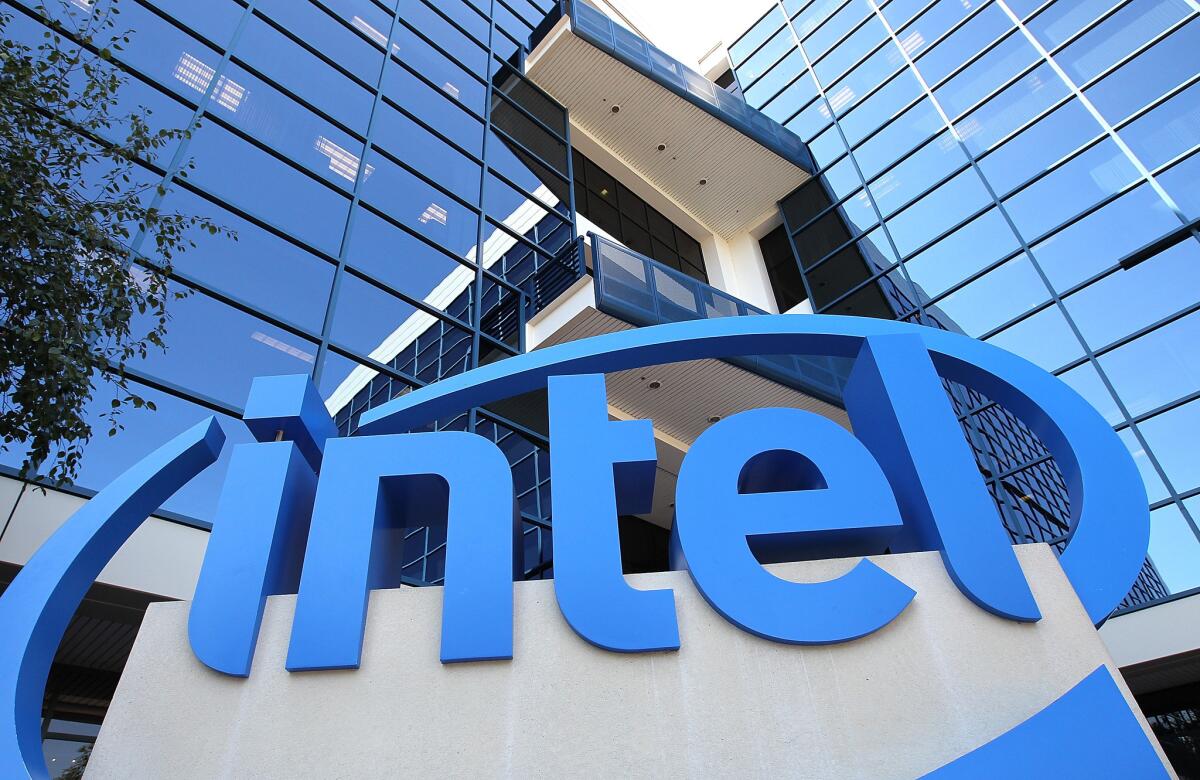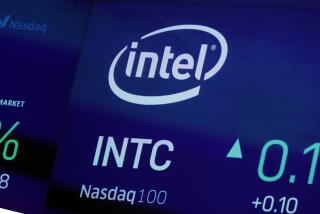Intel plunges as it weighs exit from manufacturing chips

- Share via
Intel Corp. Chief Executive Officer Bob Swan spent almost an hour on Thursday discussing an idea that would once have been unthinkable for the world’s largest semiconductor company: not manufacturing its own chips. Intel’s shares tumbled as much as 18% Friday morning.
Outsourcing is the norm in the $400-billion industry nowadays, but for 50 years Intel has combined chip design with in-house production. And until recently, Intel was even planning to churn out processors for others.
“To the extent that we need to use somebody else’s process technology and we call those contingency plans, we will be prepared to do that,” Swan told analysts on a conference call, after the company warned of another delayed production process. “That gives us much more optionality and flexibility. So in the event there is a process slip, we can try something rather than make it all ourselves.”
Pursuing this option would represent a huge shift in the industry and the end of Intel’s biggest differentiator, Cowen & Co. analyst Matt Ramsay said.
Design can do only so much for semiconductor performance. The manufacturing step is crucial to ensuring these components can store more data, process information faster and use less energy. Combining the two helped Intel improve both sides of its operation for decades.
However, Taiwan Semiconductor Manufacturing Co. has succeeded by just focusing on production and leaving the design to other companies. Its factories have passed Intel in capabilities. And that’s helped Intel rivals such as Advanced Micro Devices Inc. catch up on performance. AMD shares rose 16.50% Friday.
Intel’s current best technology, known as 10 nanometer in the industry, was scheduled to appear in 2017 and is only now making it into high-volume production. And when the company reported results on Thursday, it said the next iteration — 7 nanometer — would be delayed by a year.
“You didn’t need to read any more,” Sanford C. Bernstein analyst Stacy Rasgon said. “Whatever little credibility they had is out of the window.”
That sent Intel shares tumbling and left Swan fending off a barrage of questions from frustrated analysts on the conference call. They all asked about the manufacturing delay, its financial consequences and what Intel plans to do. The shares fell the most in four months Friday in New York to a low of $49.50.
Swan’s answers were sometimes disjointed and vague.
“What’s different is we’re going to be pretty pragmatic about — yes if, and if and when we should be making a step inside or making it outside and making sure that we have optionality to — yeah build internally mix and match inside and outside or go outside in its entirety,” he said at one point.
Intel’s back-up plan means it may tap TSMC to make its chips. But that won’t be easy, Ramsay said. TSMC’s other customers, who compete with Intel, would likely oppose the Taiwanese company prioritizing Intel’s designs, he said.
And TSMC would probably be reluctant to build lots of new production capacity for Intel when there’s a chance the U.S. company may switch back to its own factories later.
“They can’t go to TSMC because it doesn’t have the capacity,” Rasgon said.
Swan, a former CFO who took the CEO role only after reversing a decision to exclude himself from consideration, will have to make some tough decisions soon. His predecessors lauded Intel’s factories and spent billions of dollars a year keeping up with the latest manufacturing technology. Outsourcing that to another company may mean Intel never catches up again.
Swan tried to put a positive spin on the challenge when he wrapped up the conference call.
The flexibility is “not a sign of weakness,” he said.
More to Read
Inside the business of entertainment
The Wide Shot brings you news, analysis and insights on everything from streaming wars to production — and what it all means for the future.
You may occasionally receive promotional content from the Los Angeles Times.










